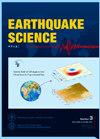基于密集阵列数据和深度学习方法的海城-秀岩地区地震活动性分析
IF 4.1
4区 地球科学
Q3 Earth and Planetary Sciences
引用次数: 0
摘要
1975年海城7.3级地震和1999年秀岩5.4级地震的余震持续时间较长。2018年至2020年在华北东部部署的中国阵列- iii密集台站,增加了海城-秀岩地区的地震监测能力,有助于建立高精度地震目录,更好地阐明两次地震的断层结构和发震机制。在海城地震震中150公里范围内选取了15个永久台站和37个中国阵列- iii型台站。接下来,我们使用深度学习方法从2018年1月至2020年7月在这些站点记录的连续波形中提取P波和s波相位。在此基础上,建立了海城-秀岩地区地震自动目录。与中国地震台网中心(CENC)的常规手册目录相比,我们的目录包含的地震事件多9.7倍,占CENC目录中地震事件的98.3%,并且具有较低的完整程度(Mc = 1.1比CENC目录的Mc = 1.8)。重新定位事件表明,海城—大杨河断裂的走向从西北到东南变化较大,表明该断裂在1975年海城MS7.3地震震源周围有轻微弯曲,可能是流体运移的通道。海城—秀岩之间的弱地震活动性表明该断裂带可能处于锁断状态。1999年MS5.4秀岩地震及其余震序列发生在康家岭断裂及其ene向共轭断裂上,两条断裂的交点与1999年MS5.4和2000年MS5.1秀岩地震的震源区域重合。因此,秀岩地震序列可能受到康家岭断裂及其共轭断裂的控制。研究表明,通过深度学习方法和密集地震阵获得的自动地震目录可以为断层结构和中强震发震机制提供有价值的信息。本文章由计算机程序翻译,如有差异,请以英文原文为准。
Analysis of seismicity in the Haicheng-Xiuyan region based on dense array data and deep learning methods
The aftershocks of the 1975 MS7.3 Haicheng and 1999 MS5.4 Xiuyan earthquakes have persisted for a long time. The ChinArray-III dense stations, deployed in eastern North China from 2018 to 2020, increased seismic monitoring capability in the Haicheng-Xiuyan region, which can facilitate the construction of high-precision earthquake catalogs to better clarify the fault structures and seismogenic mechanisms of the two earthquakes. In this study, we selected 15 permanent stations and 37 ChinArray-III stations within 150 km of the epicenter of the Haicheng Earthquake. Next, we used deep learning methods to pick P- and S-wave phases from continuous waveforms recorded at these stations from January 2018 to July 2020. Based on these picks, we constructed an automatic earthquake catalog of the Haicheng-Xiuyan region. Compared with the routine manual catalog by China Earthquake Networks Center (CENC), our catalog contains 9.7 times more seismic events, including 98.3% of the seismic events in the CENC catalog, and has a lower magnitude of completeness (Mc = 1.1 vs Mc = 1.8 for the CENC catalog). The relocated events indicate that the strike of the Haichenghe-Dayanghe fault varies considerably from northwest to southeast, indicating that the fault bends slightly around the hypocenter of the 1975 MS7.3 Haicheng earthquake which may act as a channel for fluid migration. The weak seismicity in the area between Haicheng and Xiuyan indicates that the fault section may be locked. Furthermore, the 1999 MS5.4 Xiuyan earthquake and its aftershock sequence occurred on the Kangjialing fault and its ENE-trending conjugate fault, and the intersection of the two faults coincides with the source areas of the 1999 MS5.4 and 2000 MS5.1 Xiuyan earthquakes. Therefore, the Xiuyan earthquake sequence may be controlled by the Kangjialing fault and its conjugate fault. This study shows that the automatic earthquake catalog, obtained by deep learning methods and dense seismic array, can provide valuable information for fault structures and the seismogenic mechanisms of moderate-to-strong earthquakes.
求助全文
通过发布文献求助,成功后即可免费获取论文全文。
去求助
来源期刊

Earthquake Science
GEOCHEMISTRY & GEOPHYSICS-
CiteScore
1.10
自引率
8.30%
发文量
42
审稿时长
3 months
期刊介绍:
Earthquake Science (EQS) aims to publish high-quality, original, peer-reviewed articles on earthquake-related research subjects. It is an English international journal sponsored by the Seismological Society of China and the Institute of Geophysics, China Earthquake Administration.
The topics include, but not limited to, the following
● Seismic sources of all kinds.
● Earth structure at all scales.
● Seismotectonics.
● New methods and theoretical seismology.
● Strong ground motion.
● Seismic phenomena of all kinds.
● Seismic hazards, earthquake forecasting and prediction.
● Seismic instrumentation.
● Significant recent or past seismic events.
● Documentation of recent seismic events or important observations.
● Descriptions of field deployments, new methods, and available software tools.
The types of manuscripts include the following. There is no length requirement, except for the Short Notes.
【Articles】 Original contributions that have not been published elsewhere.
【Short Notes】 Short papers of recent events or topics that warrant rapid peer reviews and publications. Limited to 4 publication pages.
【Rapid Communications】 Significant contributions that warrant rapid peer reviews and publications.
【Review Articles】Review articles are by invitation only. Please contact the editorial office and editors for possible proposals.
【Toolboxes】 Descriptions of novel numerical methods and associated computer codes.
【Data Products】 Documentation of datasets of various kinds that are interested to the community and available for open access (field data, processed data, synthetic data, or models).
【Opinions】Views on important topics and future directions in earthquake science.
【Comments and Replies】Commentaries on a recently published EQS paper is welcome. The authors of the paper commented will be invited to reply. Both the Comment and the Reply are subject to peer review.
 求助内容:
求助内容: 应助结果提醒方式:
应助结果提醒方式:


